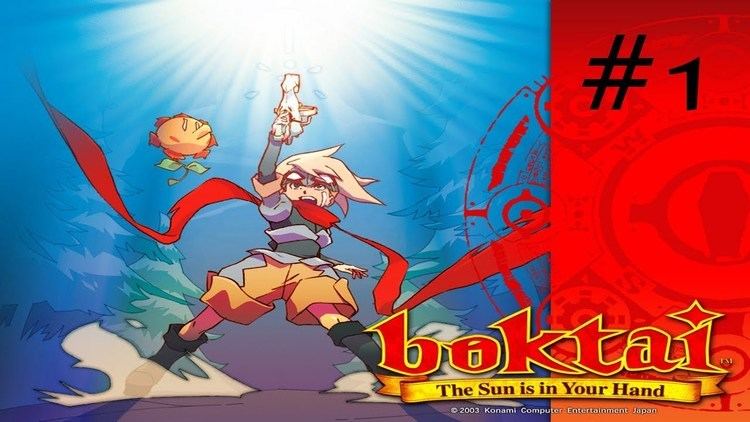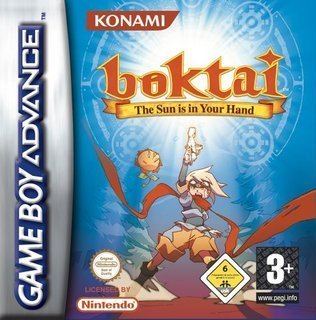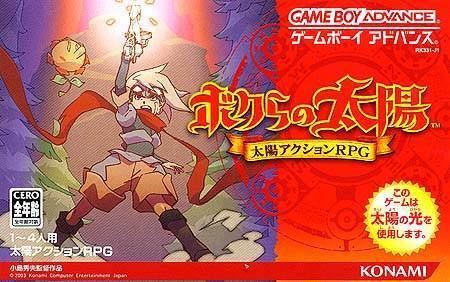8.8 /10 1 Votes8.8
83% Metacritic | 4.6/5 Emuparadise Director(s) Ikuya Nakamura Writer(s) Ikuya Nakamura Initial release date 17 July 2003 Series Boktai | |||||||||||||||||||||||||||||||||
 | ||||||||||||||||||||||||||||||||||
Composer(s) Kazuki MuraokaMasashi WatanabeNorihiko HibinoShuichi Kobori Release date(s) JP: July 17, 2003NA: September 16, 2003EU: May 14, 2004 Similar Boktai games, Hideo Kojima games, Action role-playing games | ||||||||||||||||||||||||||||||||||
Boktai the sun is in your hand playthrough part 1
Boktai: The Sun Is in Your Hand (ボクらの太陽, Bokura no Taiyō, "Our Sun" in Japan) is an action-adventure video game released on the Game Boy Advance in 2003 by Konami.
Contents
- Boktai the sun is in your hand playthrough part 1
- Boktai the sun is in your hand review gba
- Gameplay
- Reception
- Sequels
- Other media
- References

The player takes the role of Django, a vampire hunter, who uses a weapon called the "Gun Del Sol" (Solar Gun), that fires bolts of sunlight at enemies. Boktai's game cartridge includes a photometric light sensor that measures the amount of sunlight exposed to it. In order to charge the in-game weapon, the player must actually take their Game Boy Advance outside in the daytime (as verified by the light sensor). If the player's gun runs out of light reserves and there is no sunlight available, then the player must avoid enemies.

Boktai the sun is in your hand review gba
Gameplay
A unique feature of Boktai is that before a game is started, the player is prompted to set their current time and time zone. The game can then determine when the sun will rise/set, and will simulate the position of the sun inside the game. This way, the player has an advantage during the daytime because, according to lore, vampires cannot be exposed to sunlight. Sunlight also affects the world around the main character. A good example is the Solar Tree. This tree is affected by all the darkness of the Immortals, and can be cured by playing in sunlight. The game also simulates times of day by putting bird chirp sound effects in the morning, and giving the outdoor environment a soft orange glow around sunset.
Unlike other action RPGs, the combat focuses on stealth. An integral concept is shooting an undead in the back, stunning it then running away or finishing it off. Getting caught by a monster (indicated by a red exclamation point above the head) will reduce the grade received at the end of a stage. The highest grade one can receive is an "S", and the lowest a "C-". A number of other factors also determine the grade received, such as total time taken to complete the level. While playing the game, the player goes through a number of levels called dungeons. After a certain amount of these dungeons, the player will encounter a monster that is somewhat bigger than the others. These levels all called Immortal, because the four Immortals reside inside these levels. The player will have to fight his way to the boss creature, or Immortal, of the level. The player must defeat the "Bosses" and return them outside the dungeon level, to bathe and battle the Immortals into sunlight, called a Battle Drive (this is from the name of the device, used to defeat the Immortals, called the Pile Driver, summoned by Master Otenko). The player must use the solar sensor inside the game pack to defeat the Immortal. The sunlight will activate the Pile Driver. The Pile Driver will shoot the amount in sunlight to the Immortal. The Immortal will get weakened faster if the amount of sunlight is higher.
Reception
The game received "favorable" reviews according to the reveiew aggregation website Metacritic. In Japan, Famitsu gave it a score of one eight, one nine, one ten, and one nine for a total of 36 out of 40.
Sequels
Boktai was followed by two sequels also on the Game Boy Advance: Boktai 2: Solar Boy Django and Shin Bokura no Taiyō: Gyakushū no Sabata (also known as Boktai 3: Sabata's Counterattack) - the latter was released exclusively in Japan. Both GBA sequels also employed the used of a solar sensor on their cartridges. A fourth game was released for the Nintendo DS titled Bokura no Taiyō: Django & Sabata, released outside Japan under the title Lunar Knights. The name change was an attempt to rebrand the series after the fourth game abandoned the use of a Solar Sensor (due to the Nintendo DS using cards instead of cartridges).
Other media
A manga was produced called Solar Boy Django. It was produced by Makoto Hijoka and was loosely based on the Boktai storyline. It was written by Makoto Hijoka and published in Shogakukan's CoroCoro Comic from September 2003 to July 2007. It does not follow the plot of the games directly, although it does include many of the characters, such as the Count and Sabata. An English version of the manga is currently available from a Singapore manga production company. In 2007, Elex Media Komputindo licensed the manga for the Indonesian market with the title Jango the Solar Boy.
